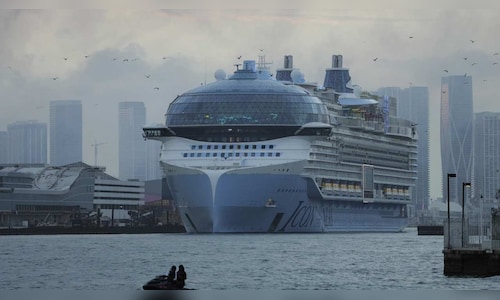As a long-term solution, the Port of Barcelona, the busiest cruise hub in Europe, has decided to reduce its terminal capacity by the end of the decade to curb overtourism and ease the strain of rising visitor numbers.
An agreement announced on between the city council and port authorities on July 17 will see the number of cruise terminals cut from seven to five by 2030. This move is expected to lower the port’s capacity for handling cruise passengers from 37,000 to 31,000.
Also read | Overtourism in Spain: Locals unable to enjoy their own beaches, heading to other places
“For the first time in history, limits are being placed on the growth of cruise ships in the city,” said Barcelona’s mayor, Jaume Collboni, during the announcement.
Official figures show that cruise traffic at the port surged in the first five months of 2025, with a 21% increase in ship calls and a 20% rise in passenger numbers compared to the same period in 2024, Reuters reported.
A total of 1.2 million cruise passengers visited between January and May this year, which is a sharp uptick in activity following a 20% growth in cruise arrivals between 2018 and 2024.
The rise in tourism has sparked growing discontent among residents and prompted public demonstrations against overcrowding and its impact on daily life, particularly at popular landmarks.
Also read | Fed up with overtourism, protesters take to streets in southern Europe
Earlier, Reuters quoted Mayor Collboni as saying that he was seeking to renegotiate terms with the port to reduce the number of one-day cruise visits. These short stays often result in overcrowding at major sites such as the Sagrada Familia, without any corresponding economic benefits of overnight tourism.
As part of the new arrangement, three existing cruise terminals will be merged into a single larger facility. The port will give priority to cruise lines that designate Barcelona as their home port for embarkation and disembarkation. The intention is to promote longer visitor stays and increased local spending, rather than brief stopovers.
Environmental concerns too play a role in the port’s redesign. Port authorities have confirmed that the modernisation plan includes connecting docked ships to the local power grid, allowing them to shut off engines while at port, reducing emissions.
European Union regulations mandate that by 2030, major maritime ports must provide onshore power infrastructure to lower carbon emissions. However, a recent study warned that most European ports are currently behind schedule in meeting the requirements.
Barcelona’s decision to rethink its cruise tourism management is a positive sign as cities across Europe face mounting pressure to balance economic benefits from tourists with environmental sustainability and enhance quality of life for residents.
(Edited by : Jerome Anthony)
First Published: Jul 19, 2025 12:05 PM IST






